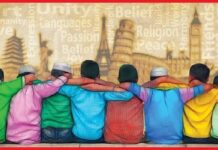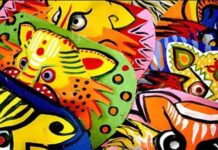Shaila Simi Nur:
I just have visited an exhibition entitled Brick lane 1978 (The turning point) by photographer Paul Trevor.
This exhibition documents battle for justice which was sparked by the racist murder of 24-years-old Altaf Ali in May 4th 1978. It has relationship with me in many ways. It is the month of my birth and this exhibition pays tribute to a generation of Bangali activists actions helped shape the struggle for social equality in the UK.
The exhibition features photographs of five years but is originally based on the death of Altaf Ali and about the antiracism movement that surrounds this incident.
Meeting the man who is precious to me-
When I arrived at the Four Corners Gallery I found that, the exhibition was closed. A man was there, standing in a corner. Seeing his face, a light flowed through my heart! And I asked him about the photographer. Actually, he was Paul Trevor, the photographer.
I believe, Paul Trevor is one of the authors of the history of Bengalis independence in exile.
We toured the whole exhibition together. He described the beginning and growth of the periodic movement and all the backgrounds before and after. I believe Paul Trevor is one of the authors of the history of Bengalis independence in exile.
Paul said -“We did not think that, it was the transformation moment” In 1970’s photographer Paul Trevor Recorded lives of east London’s Bangali community. The exhibition explores this watershed moment bringing together seventy of Paul’s photographs for the first time.
Paul told me that Altaf Ali woke up in that morning on the day of his death as a working-class common man. But just after death, he has become a legend.
His Last journey was given with state honors. Horse-drawn carriages in front, black carriages, coffins, etc., the way a legend goes, the way he went. Not only that also the life of the Bengalis in United Kingdom has changed by this incident.
The exhibition’s layout is
The daily life of a Bengali,
Everyday Racism,
Some pictures of Brick lane,
Racist Movement,
Racist attack,
Housing,
Youth group,
Blood on the street
Rock against racism
&
The Turning Point 
There is a picture of Brick Lane, where two Bengalis are working in a clothing sweatshop. There are notable pictures… one of the photos of an underground school to inspire children to practice Bangla language and Bengali culture.
There is a picture of a living room. They have secretly taken refuge there from the oppression of racism. Then the daily movement is described with various dates.
There are pictures of the history of how St. Mary’s Garden became Altaf Ali’s Park.
There is a photo of the work strike. That was the first such movement in the United Kingdom.
There are pictures of a national organization who were only involved with the anti-racism movement.
And also 51 Bengali Activists’ names of that time have been collected.
It was like I had a dreamy journey. I found myself in the middle of it all. When I first came to this country in 2003, I fell victim to egging buildings. Many more incidents seemed to be calling and the recent tragic incident came to mind, the statement about the greatest human being Hazrat Muhammad (PBUH).
After this recent incident I asked myself why our behavior and language not changed! Why are we racist even though we are so modern? Besides protesting, we need to understand the reason. We need to move towards an ideal life for education and mental development.
-Writer Shaila Simi Nur is a Sufi Artist and Poet. She is Former Miss Ruposhi Dhaka, Bangladesh
































